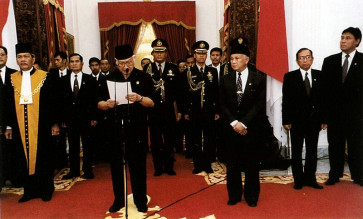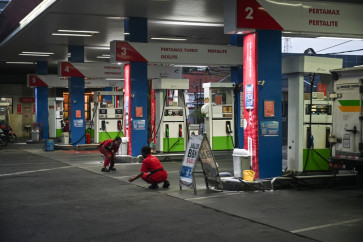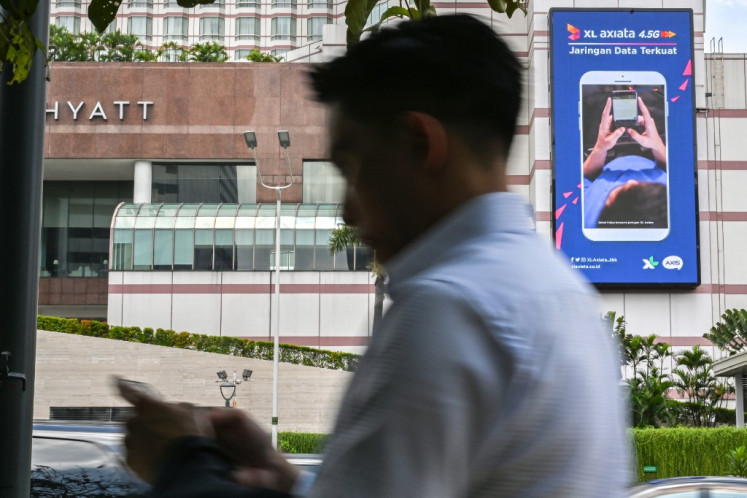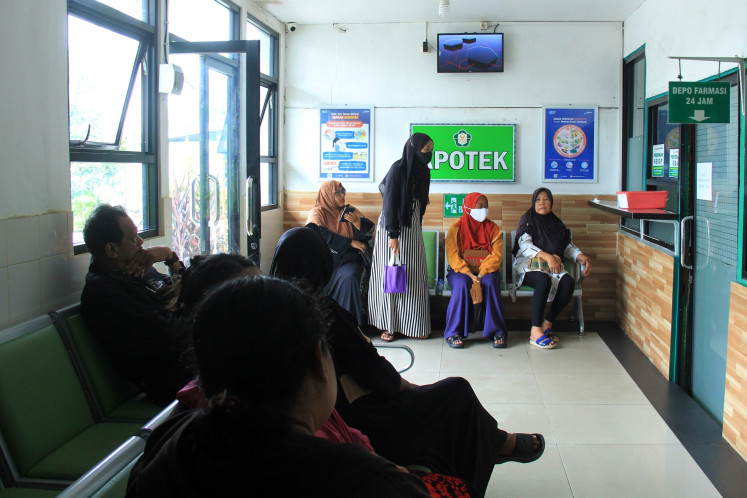Popular Reads
Top Results
Can't find what you're looking for?
View all search resultsPopular Reads
Top Results
Can't find what you're looking for?
View all search resultsIndonesia’s underwater charms attracting new divers
Submerged: Beginning divers practice in a local pool, and pose for photos
Change text size
Gift Premium Articles
to Anyone
Submerged: Beginning divers practice in a local pool, and pose for photos. Courtesy of Dive Indonesia
What is hidden underneath the surface and the sensation divers feel when they go deep underwater have made people believe that heaven really lies in Indonesian waters.
But it was not until at least three years ago that people started to understand the marine biodiversity of Indonesia’s waters, marked by a steady increase in the number of people taking scuba diving courses.
The word “scuba” itself is an acronym for self-contained underwater breathing apparatus.
Elisa Hakim, 32, took a scuba diving course last year. “At first, I had a traumatic experience with diving, I hurt my ears when I first learned how to dive a few years ago.”
She was then enticed by many of her friends to try it again, and she realized her friends had a point.
“Last year, a friend referred me to a trusted instructor, and now diving has been an inseparable part of me,” she said.
Elisa, now a certified diver with the SSI (Scuba Schools International) diving certification agency, said that she arranged at least one diving trip every two months to alleviate the stress she experienced at work.
“The world down there is very different from the world I live in. I get to enjoy the scenery, the beautiful coral and meet unique creatures. But what’s more important, I feel so peaceful when I dive,” said the woman who loves watching schools of fish swirling underwater.
Stretching from the western-most part of Indonesia through to the nation’s eastern-most tip, Indonesian waters are home to at least 700 dive sites with thousands of marine species — from the tiny pygmy seahorse to the gigantic whale shark.
Learning: Instructors teach new divers how to use equipment and manage their buoyancy. Courtesy of Dive Indonesia An increase in number of people interested in diving has been recorded at several dive centers in the capital and across the country.
The owner of Global Dive, John Sidjabat, said his dive center had seen a 20 to 30 percent increase in the number of new divers since three years ago.
“Five years ago, Global Dive certified around 50-60 new divers a year. But since 2009, we certified more than 100 students,” John said.
In 2012 alone, Global Dive certified 120 beginning divers.
John said that the high number of people taking diving certification courses could be driven by the massive promotion of dive sites scattered throughout the nation’s 17,000 islands.
“They may have seen from TV commercials or from media reports that many foreign tourists come to Indonesia to dive,” he said.
“In addition, many have tried snorkeling before and were amazed by the scenery they saw, so they believe that the scenery deep in the water will definitely be more beautiful.”
Smooth sailing: Instructors accompany new divers underwater. The country is seeing an increase in dive course participants. Courtesy of Dive Indonesia Global Dive issues NAUI (The National Association of Underwater Instructors) diving certifications. Most students taking diving certification courses at Global Dive are from Jakarta. But John said that there were currently more people from Bandung in West Java and Surabaya in East Java learning to dive with the center.
“Maybe the high stress levels they face have made them look for a way to relieve the distress,” he said.
Another dive center that has seen an increase is Bubbles Dive Center in South Jakarta, which issues PADI (Professional Association of Diving Instructors) certifications.
One of its in-house instructors, Yeyen Taryono, said the dive center had recorded a significant increase in the number of students since 2010, with around 300 students per year.
“Actually, diving has been quite famous since 2000, but people just started to get crazy about it in the past three or four years,” he said.
However, he said only a handful of beginning divers decided to continue to higher certification levels.
Commonly, there are five levels of scuba diving certifications issued by authorized agencies: beginner, advanced, rescue diver, dive master and dive instructor.
For beginners, the courses usually start with theory sessions and introductions to the equipment used, and techniques to breathe underwater at a swimming pool that is specifically designed for diving courses. In Jakarta, a swimming pool near Gelora Bung Karno Stadium in Central Jakarta is used by many dive centers for their courses.
Yeyen said that students were taught, among other things, how to reduce the pain people usually feel in their ears caused by the pressure of the water as they start to descend, how to clear a fogged mask, how to breathe through the regulator and how to control their buoyancy.
“The higher the certification they take, the more techniques they will obtain. Like when divers take advanced certification, they will also learn how to deep dive and night dive,” he said.
In Indonesia, there are at least four diver training agencies that issue recreational diving certifications, namely PADI, SSI, CMAS (Confederation Mondiale des Activites Subaquatiques) that is affiliated with The Indonesian Diving Association (POSSI), and NAUI.
Cipto Aji Gunawan, a marine ecotourism development and management consultant who also works with the Tourism and Creative Economy Ministry to develop the archipelago’s marine sector, said dive tourism had been developing fast in recent years in line with the high number of people looking for recreational diving.
Although diving also means exposure to an area and potential damage to pristine sites, at the same time the presence of divers could indirectly control the sites’ destruction, which is still rampant, he said.
“For example, when there was destruction at some dive sites around Komodo [in East Nusa Tenggara], some tourists and dive operators reported it to the authorities,” Cipto said.
Cipto warned that although diving was not the main cause of the destruction of marine ecosystems, it could eventually degrade the environment if divers were not aware of their underwater surroundings.
New world: The coral diversity is glorious and on display for those who know how to scuba dive in Wakatobi, South Sulawesi. JP/Arief Suhardiman
“The most important thing is the awareness, the basic knowhow of the diver so they can always make diving fun but also take part in preserving it. Dive centers should highlight this too to their students,” he said.
In addition, a specific regulation that regulates diving and its impact on local tourism was needed to help preserve marine ecosystems.
“Currently, the government is deliberating a regulation that includes standard operational procedures for dive operators. The aim is not only to preserve the marine ecosystem, but also for the safety of divers,” Cipto said.
The archipelago has approximately 51,000 square kilometers of coral reef. According to data from Reefs At Risk in Southeast Asia, if the conservative estimate is accurate, 51 percent of the region’s coral reefs and 18 percent of the world’s coral reefs are found in Indonesian waters.













